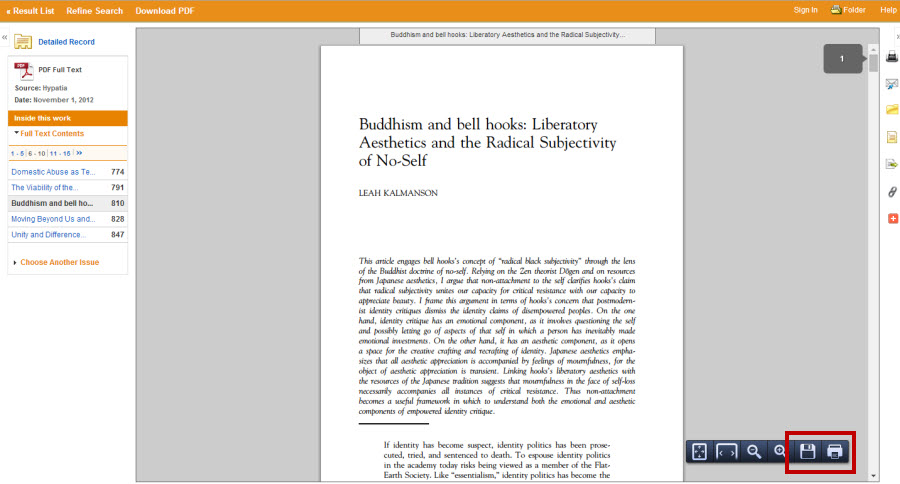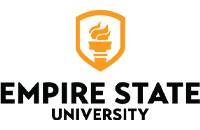Saving Search Results
Get a Link to a Specific Result or Set of Results (Permalink)
Also known as persistent URLs (PURL) and stable URLs, permalinks are direct links back to online articles (or searches) once you have left a database.
In many databases, the web addresses (URL) in your browser's address bar are dynamically generated in the case of articles in databases, and will only work for your current login session. This means that once you leave the database, that URL will not take you back to the article in question, nor will it take your instructor, classmates, or anyone else to that article.
So, in addition to the web address in your browser's address bar, the database also gives you a permalink, which will take you directly to the article. Every database handles permalinks differently, so here are database-by-database instructions on how to locate permalinks.
In OneSearch, you can also save a specific search using the "Save Query" link located just above the first result on the results page.
Note: If your instructor gives you a link to an article and it does not work, chances are that instructor is not familiar with permalinks. Please, direct the instructor to https://subjectguides.sunyempire.edu/permalinks or to Ask A Librarian.
Example in OneSearch:
- Click on the chain link icon to the right of a result title on the results page to display the Permalink.
- This will display a URL a little further down the page that you can copy-paste into a word document, email or elsewhere for later use or to share with others.

Your Temporary List
Some databases (including OneSearch) call this your folder. Some do not call it anything. But almost every database provides a way to collect and save search results that interest you, though features may appear somewhat differently in different databases.
Note: These lists and folders are temporary. As soon as you log out or close the window, everything you have saved is gone for good, unless you create an account with that database (free, but separate from your college login and password). If you are logged into that account, your folder or list of search results will be saved.
Example from OneSearch Search Results Page
To add an item to your favorites (folder), click the little pin icon to the right of a result.
Example from EBSCOHost Article Information Page
Click "Add to folder" (highlighted in red), located in the Tools Menu on the right side of the Article Information Page.

View of Folder Contents in OneSearch
When there are items in your folder, the pin icon at the top-right of your screen will take you to a page of those items (highlighted in red below).

To view what you have saved to your OneSearch folder, click the pin icon at the top of the page (as in the example above). You will see a list of your saved items adjacent check boxes and other options. See below.

Use the checkboxes to select any or all of the items in the folder to Print (just the citations, not the full-text), Email, Save (to your computer), or Export (to a reference management tool) the item using the icons on the right.
Note: Print, Save, and Email usually records the citation information and abstract. You must open the full-text file itself if you want to print or save the full text.
Printing, Emailing and Saving
To print or save the actual PDF full text of an article, open the PDF full text and use the icons that appear at the bottom-right of the page when you hover over it with your cursor.
Once you have saved the PDF, you can also email it to yourself or someone else as an attachment.

Exporting to a Reference Management Tool
A reference management tool (or citation manager) is a piece of software that:
- gathers together the information you will need to cite all the information sources you are using
- saves the full text of digital information sources
- often lets you make notes and highlights
- inserts citations into your paper, and formats them for you.
You can usually log in from any computer with an internet connection to access all of these resources.
We highly recommend choosing, installing, and learning to use one of the free, recommended reference management tools available.
Once you have yours installed, follow the instructions provided for that tool to import content from a database (or website). You may be able to use the Export function found in the Saved Items folder or on any Article Information Page; however, the Export function rarely includes the full text You usually need to save the PDF and add it to your reference management tool. It is worth the extra effort to have everything on one place.
Reference management tools can format your citations for you, but they are only as good as the information that you enter. Double check your manual entries as well as items imported from databases for spelling, capitalization, punctuation and accuracy.
Removing Items from Folder or Temporary List
To remove an from your list/folder, click the same pin or folder icon or checkbox you used to add it.
Accessibility Note
Please note: If you need to request accommodations with content linked to on this guide, on the basis of a disability, please contact Accessibility Resources and Services by emailing them. Requests for accommodations should be submitted as early as possible to allow for sufficient planning. If you have questions, please visit the Accessibility Resources and Services website.

